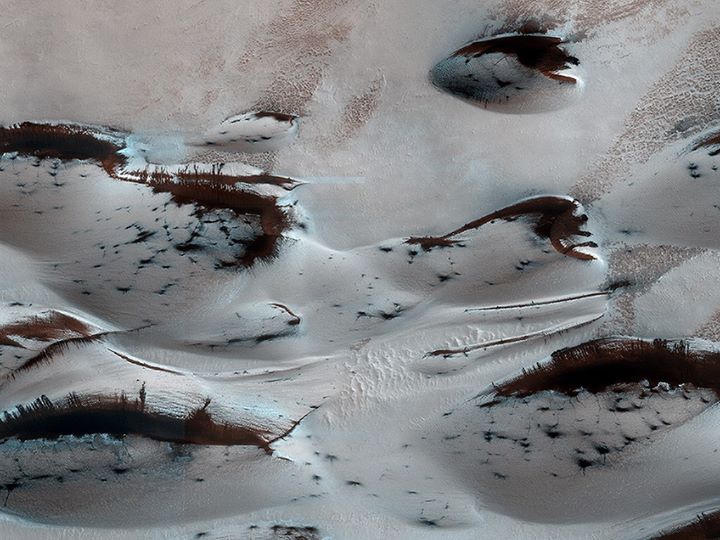 Project title: Carbon dioxide as a geomorphic agent on Mars
Project title: Carbon dioxide as a geomorphic agent on Mars
Funded by: Mars Fundamental Research Program, NASA and Trinity College Dublin.
Research team: Professor Mary Bourke (TCD); Professor Jim McElwaine (Durham); Dr. Candice Hansen, (Planetary Science Institute); Dr. Serina Diniega (JPL); Ms Lauren McKeown (Postgraduate, TCD), Dr Joanna Nield (University of Southhampton), Dr Susan Conway, (Open University).
Duration: 2014-2017
———————————————
Project Summary:
Sublimation of Mars’ seasonal CO2 ice cap causes geomorphologic changes on the surface of Mars in today’s climate. There have been many elegant hypotheses about how this works, and circumstantial evidence to support these hypotheses, but there is no quantitative data to assess CO2-sublimation-driven processes. The aim of this proposal is to combine data from lab experiments with theoretical models and field tests to quantify the modification of a sandy surface resulting from the levitation and sublimation of CO2 ice on or buried within that surface. We will test and observe the interaction of CO2 ice with granular material in a controlled environment in the lab under both Earth and Mars conditions. We aim to provide clear quantitative measurements of CO2 levitation and sublimation as it interacts with the surface and subsurface. Field experiments with dry ice on dunes will test scenarios in more natural environments and allow changes in experiment scale. The model will be carefully developed to allow us to extrapolate our results from Earth to Mars and from lab to field. Data generated in the lab and in the field will be folded back into the model to refine its accuracy and precision. This combined approach with lab, field, and numerical facets will allow us to estimate erosion rates for furrows on dunes, formation of linear gullies on dunes, and evaluate the effect of particle size and cohesion on erosion of araneiform terrain, just to list a few examples. All surfaces on Mars covered seasonally with CO2 ice can be examined within this framework.
Seasonal processes involving CO2 ice on Mars have no Earth-analog. Our approach will be the first to quantify the relative efficacy of pressurized CO2 gas as an agent of erosion and to document the resultant surface changes under laboratory and field conditions. Our analyses will contribute to NASA’s broad goal of increasing the scientific understanding of geologic processes on planetary surfaces.
Publications:
Mc Keown, L. E., M. C. Bourke, and J. N. McElwaine (2017), Experiments On Sublimating Carbon Dioxide Ice And Implications For Contemporary Surface Processes On Mars, Scientific Reports, 7(1), 14181, doi:10.1038/s41598-017-14132-2.
Hansen, C. J., S. Diniega, N. Bridges, S. Byrne, C. Dundas, A. McEwen & G. Portyankina (2015) Agents of change on Mars’ northern dunes: CO2 ice and wind. Icarus, 251, 264-274
Hansen, C. J., Byrne, S., Portyankina, S., Bourke, M.C., Dundas, C., McEwen, A., Mellon, M., Pommerol, A., and Thomas, N.,(2013), Observations of the Northern Seasonal Polar Cap on Mars I. Spring Sublimation Activity and Processes: Icarus, Vol. 225, 2, p 881-897, doi.org/10.1016/j.icarus.2012.09.024 PDF
49. Diniega, S., Hansen, C.J., McElwaine, J.N., Hugenholtz, C.H., Dundas, C.M., McEwen, A.S., Bourke, M.C. (2013) A new dry hypothesis for the formation of Martian linear gullies. Icarus. Vol. 225, 1, p. 526-537. PDF
Hansen, C., Bourke, M.C, Bridges, N.T., Byrne, S., Colon, C., Diniega, S., Dundas, C.M., Herkenhoff, K., McEwen, A., Mellon, M.T., Portyankina, G. and Thomas, N. (2011) Seasonal Erosion and Restoration of Mars’ Northern Polar Dunes. Science, 331, 575, DOI: 10.1126/science.1197636. PDF
Conference Presentations
2017
- McElwaine, J.N., Diniega, S., Hansen, C.J., Bourke, M., Nield, J., (2017). The Formation of Martian Dune Gullies by Dry Ice-Experiments and Modelling, Fifth International Planetary Dunes Workshop, Utah. Abstract #3035
- Mc Keown, L. , Bourke, M.C and McElwaine, J. (2017) A Laboratory Investigation of the Agency of Sublimating Carbon Dioxide Ice in Martian Feature Formation. LPSC, Huston, USA. Abstract #1330
2016
- Bourke, M.C., Nield, J.M., Diniega, S., Hansen, C.J., McElwaine, J.N., (2016). The instigation of dry-gully morphology by CO2 block movement across dark basaltic dunes, Arizona, Martian Gullies and their Earth Analogues, Geological Society, London.
- Bourke, M.C., Nield, J.M., Diniega, S., Hansen, C.J., McElwain, J.N., 2016. A field study of the geomorphic effects of sublimating CO2 blocks on dune slopes at Coral Pink Dunes, Utah., EGU.
- Bourke, M.C., Nield, J.M., Diniega, S., Hansen, C.J., McElwain, J.N., Titus, T.N., 2016. The geomorphic effect of sublimating CO2 blocks on dune lee slopes at Grand Falls, Arizona., LPSC, abs. #2407 [PDF].
- Hansen, C. J. Portyankina, G, Diniega, S. Bourke, M.C. Bridges, N. Byrne, S. Dundas, C. Hayne, P McEwen, A. Thomas, N.A decade of imaging Mars’ seasonal polar processes with HiRISE. Mars Polar Conference.
- Mc Keown, L. , Bourke, M.C and McElwaine, J. (2016) A Laboratory Investigation of the Agency of Sublimating Carbon Dioxide Ice in Martian Feature Formation. Irish Geomorphology Group annual workshop, University College Cork.
- Mc Keown, L. , McElwaine, J. and Bourke, M.C (2016) A Laboratory Investigation of the Role of Sublimating Carbon Dioxide as a Geomorphic Agent. Martian Gullies and their Earth Analogues, Geological Society, London.
- Mc Keown, L., Bourke, M.C. & McElwaine, J., (2016). An Investigation Into the Potential Role of Carbon Dioxide Sublimation in Linear Gully Pit Formation on Mars. Sixth Mars Polar Science Conference, 2, p.20631.
2015
- Mc Keown, L. , McElwaine, J. and Bourke, M.C (2015) A Laboratory Investigation of the Role of Sublimating Carbon Dioxide as a Geomorphic Agent. Irish Geomorphology Workshop. Dublin.

Leave a comment